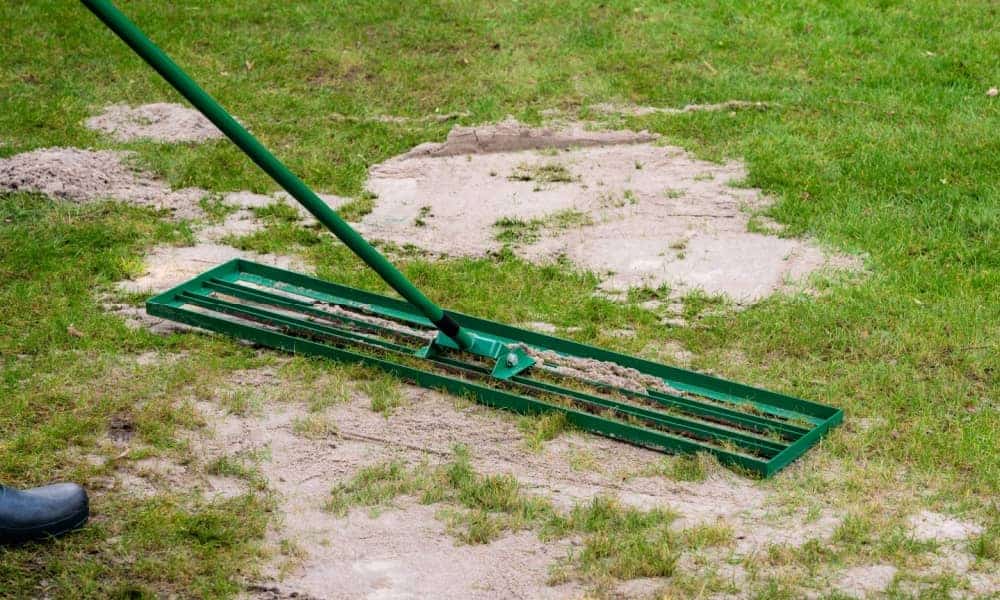Australian lawns face it all — very hot summers, heavy rains, and everything in between.
Over time, your lawn becomes bumpy and nutrients are washed away from the soil.
Even starting a new lawn can be challenging, especially if you’re after a thick, green turf.
Don’t stress — top dressing your lawn might just be the key!
Benefits | Materials | When to Top Dress | How to Top Dress a Lawn | After Top Dressing
What Is Top Dressing?

Top dressing involves spreading a thin layer of material — like compost or sand — over the soil’s surface.
The top dressing material gradually integrates with the existing soil and improves its structure.
It’s an eco-friendly way to create a healthy lawn without using heaps of fertilisers and pesticides.
Plus, no digging is required!
Benefits of Top Dressing a Lawn
Top dressing a lawn offers a range of benefits, from keeping your space lush to levelling the ground.
BETTER SOIL HEALTH: Top dressing, especially with compost, adds beneficial microbes and nutrients to the soil.
ENHANCED SOIL STRUCTURE: Top dressing can improve soil aeration, drainage, and moisture retention.
HEALTHIER GRASS GROWTH: Rich soil encourages the grass to form a healthy root system and lush foliage.
REDUCED THATCH: Top dressing helps break down thatch (aka dead plant material) and allows the grass to absorb water and nutrients better.
LEVELLING THE SOIL: Top dressing fills uneven areas to create a more uniform surface.
What Is the Best Top Dressing for Lawns?
The best top dressing material depends on the specific needs of your lawn.
It should also complement the existing soil type, have a similar consistency, and maintain the pH level.
Moreover, choose a top dressing that suits the grass you have and helps it thrive.
That said, you can top dress your lawn with compost, sand, topsoil, or a mix of these. Each material offers unique benefits.
Compost

Compost is excellent for top dressing a lawn. It’s made from decomposed leaves, dead grass clippings, or manure.
It enriches the soil with organic material and nutrients like nitrogen, phosphorus, and potassium.
When applied to clay soils, compost helps prevent soil compaction and improve drainage. In sandy soil, it boosts moisture retention.
Before top dressing with compost, make sure it has fully decomposed.
To check, the compost should look and smell like soil. If it still has a strong rotten odour, let it mature longer.
Sand
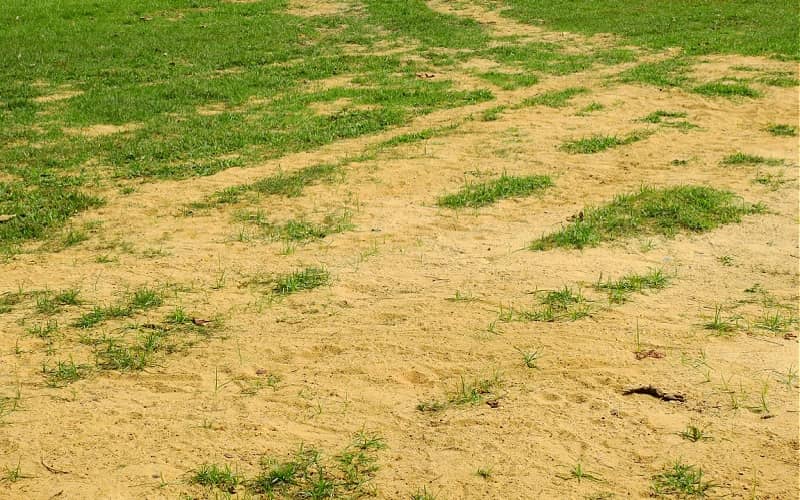
Sand is often used as a lawn dressing to loosen heavy clay soils and level uneven lawns.
The best sand for top dressing a lawn depends on the specific soil type. A common mix is 70% coarse sand and 30% loam soil.
While you can use straight sand for an ultra-flat surface, don’t overdo it.
Repeatedly top dressing with pure sand can gradually deplete soil nutrients.
Also, keep in mind that coarse sand is best for top dressing.
It has larger particles that create gaps in the soil, which improve water and air flow.
Do not use fine sand! Its tiny particles fill soil pores and worsen compaction.
NOTE: Don’t mistake ‘lawn sand’ for regular sand. Lawn sand is a mix of sand and iron sulphate. It’s often used for moss control.
It’s not ideal for top dressing as it can alter the soil pH.
Topsoil
Topsoil works very well for top dressing, especially if you want a lush, green lawn.
Look for topsoil rich in organic matter and nutrients to support healthy grass growth.
Also, make sure that the topsoil dressing mix is compatible with the existing soil. This helps the topsoil integrate naturally with your lawn.
It also prevents layering issues, which can disrupt drainage and plant growth.
For clay soils, use a mix with coarse sand to improve drainage.
For loam soils, use a balanced blend of sand, silt, and clay.
For sandy soils, use a mix with sandy loam to boost moisture retention.
Custom top dressing mix
One kind of top dressing material may not provide everything your lawn needs.
The good news is that you can make your own top dressing mix! This allows you to address the specific needs of your lawn.
First, assess the soil type. Is it sandy, clay, or loamy?
Also, check for issues like uneven surfaces, poor drainage, or unhealthy grass.
Identifying the problems on your lawn will help you create the right blend.
Here are some top dressing mixes to get you started:
- For loam soil: 60% compost and 40% loam soil
- For sandy soil: 60% compost and 40% sandy loam
- For clay soil: 40% compost, 30% coarse sand, and 30% loam soil
Keep in mind that the ratios above are just a guide. You may need to adjust them based on your lawn’s condition.
For instance, if your clay soil is extremely compacted, add more sand. If it’s low in nutrients, increase the compost.
You can also add organic fertilisers or soil conditioners for an extra boost.
To blend the materials well, use a garden fork or shovel.
Small batches can be mixed in a wheelbarrow. For larger amounts, mix directly on the ground.
When to Top Dress a Lawn in Australia
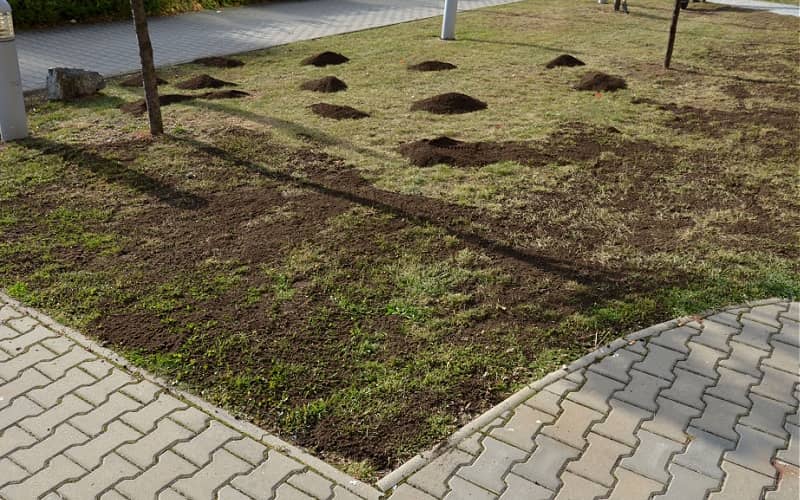
In Australia, the best time to top dress a lawn is during the growing season.
For warm season grasses like Buffalo, Couch, and Kikuyu, top dress in spring to early summer.
For cool season grasses like Bent Grass and Fescue, top dress in autumn when temperatures are lower.
The same recommendations apply to Australian native grass lawns, if you need to restore soil nutrients or improve the structure.
Do not top dress your lawn in winter when the grass is dormant. Otherwise, you can suffocate and kill the entire lawn!
How Often to Top Dress a Lawn
For general maintenance, top dress the lawn yearly to maintain soil health.
To address major issues like uneven areas and poor drainage, you can top dress up to twice a year.
Keep in mind that the ideal frequency depends on your lawn’s condition.
Closely monitor your lawn after top dressing and adjust the frequency as needed.
How to Top Dress a Lawn
Top dressing is labour-intensive, especially for big lawns.
That’s why it’s normally done by lawn care experts. They can also help you determine the best top dressing material for your lawn.
But if you’re up for the task, you can top dress a lawn on your own.
Here are the materials you’ll need:
- Rake
- Shovel
- Mesh sifter
- Grass seeds
- Lawn mower
- Lawn aerator
- Soil pH tester
- Wheelbarrow
- Top dressing material
- Garden hose or sprinkler
Always wear gloves and a dust mask when working on your lawn to protect yourself from potential irritants.
Step 1: Prepare the lawn
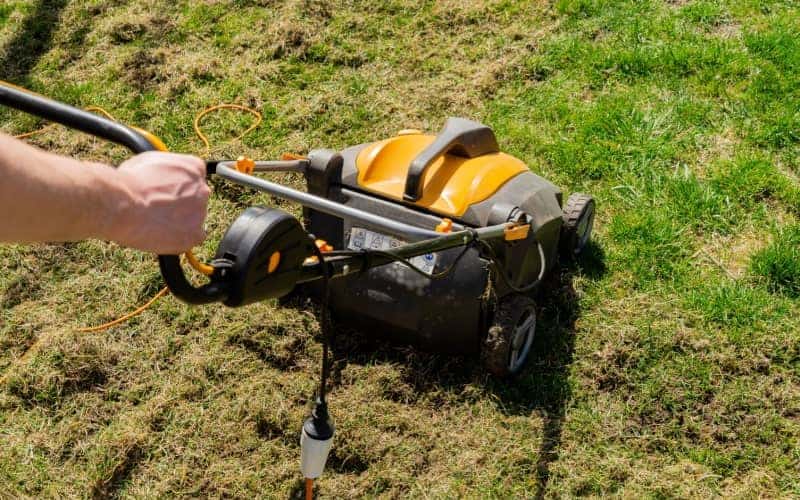
Inspect your lawn for issues like uneven spots, thin grass, or poor drainage. This helps you choose the right top dressing material.
Clear away any debris from the area. If there’s too much thatch, dethatch the lawn first.
Afterwards, mow the lawn to about two-thirds of its height but avoid scalping it or cutting below 4cm.
Then, use a core or manual aerator to create holes in the soil.
Mowing and aerating a lawn beforehand lets water and nutrients reach the grass roots easily.
You can mow up to a day before, but top dress right after aerating to maximise the benefits.
Step 2: Prepare the top dressing material
Use a top dressing material that suits the type of soil and the condition of your lawn.
Test the pH of the top dressing material with a soil pH tester.
Keep in mind that it should be compatible with the soil on your lawn, from pH levels to composition.
Before applying, screen the material with a mesh sifter to remove clumps, rocks, and any debris.
Step 3: Apply the top dressing
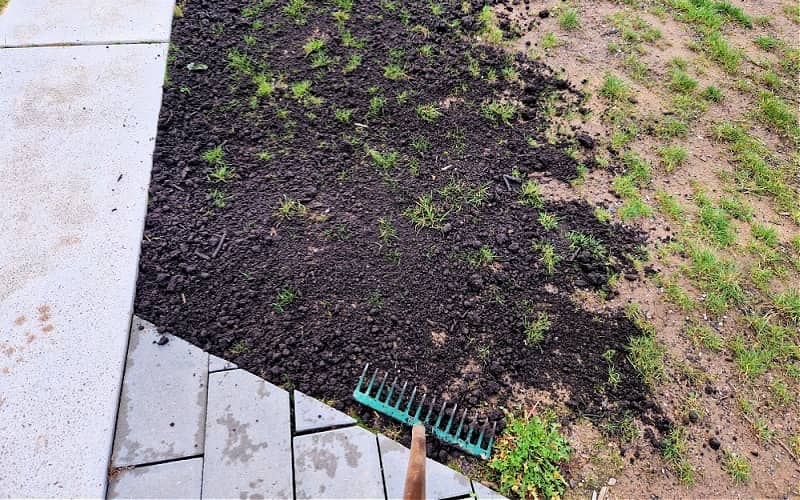
Apply a thin layer of top dressing, about 0.5–1.25 cm thick.
Using too much dressing can smother the grass or cause water to pool in different parts of the lawn.
For small lawns, use a shovel to spread the top dressing. For larger areas, a compost spreader works best.
Work on one section at a time for thorough coverage. Then use a levelling rake to smooth the entire surface.
Step 4 (optional): Overseed the lawn
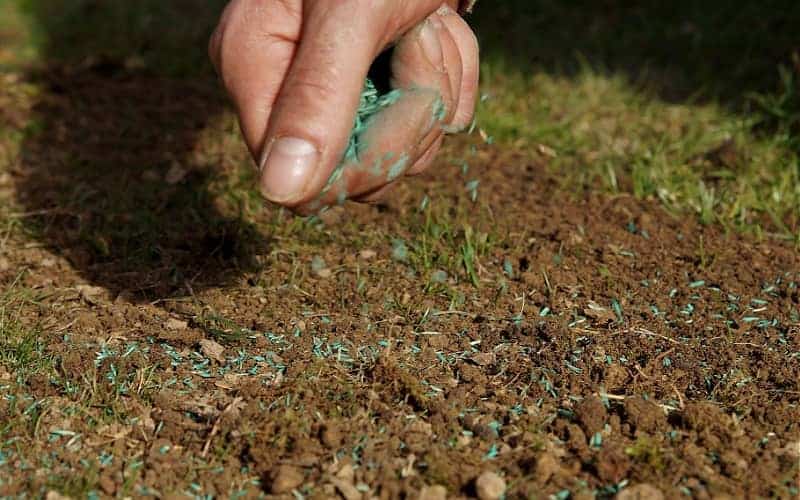
Overseeding can make your lawn thicker and encourage grass growth in sparse areas.
Choose a grass suited to your soil and climate. Then evenly spread grass seeds over the top dressed area.
Use a rake to mix the seeds in. This ensures good contact with the soil and promotes germination.
Step 5: Water the lawn
Lightly water the lawn to help the top dressing material settle and blend into the soil.
What to Do After Top Dressing a Lawn
After top dressing your lawn, it will take a few weeks to see new growth.
In the meantime, stay off the lawn for a few days to let the top dressing settle.
Keep the top 5cm of the soil consistently moist by watering whenever it feels dry. This will encourage grass to grow.
After every watering, check the soil. It should feel damp but not soggy, which indicates proper drainage.
Wait 10–14 days before mowing to avoid disturbing the top dressing and damaging new seedlings.
With a little patience, you’ll soon enjoy a thicker, healthier lawn!
FAQs About Top Dressing a Lawn
Learn more about how to keep your lawn greener and fuller!
What is the best top dressing for a Buffalo lawn?
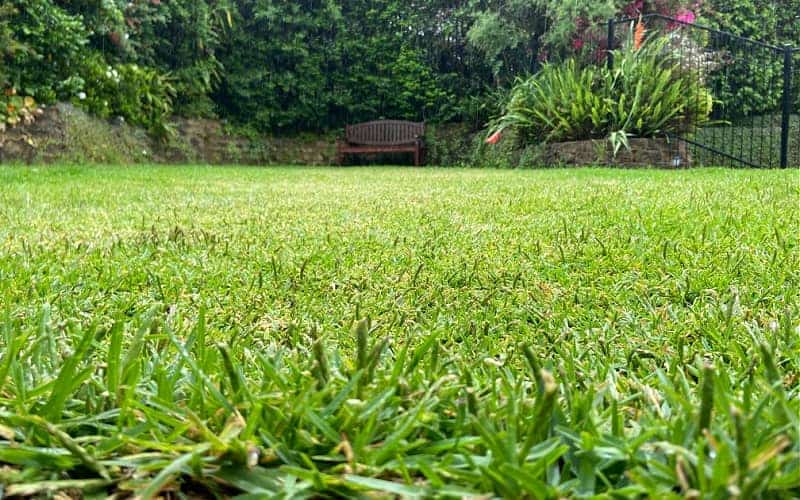
A blend of 50% compost and 50% sandy loam topsoil is best for Buffalo lawns.
This mix provides both nutrients and improved drainage, which is ideal for Buffalo grass.
Do not use heavy clay topsoil, which can lead to waterlogging.
How do you top dress an existing lawn?
Before top dressing an existing lawn, dethatching is essential to prevent buildup.
Applying a thin layer of top dressing is also crucial to avoid suffocating the grass.
If only certain areas are thinning, you probably don’t need to top dress the entire lawn.
Instead, fix a patchy lawn by applying the top dressing material directly to the bare spots.
Lightly rake the bare soil to loosen it before applying the top dressing.
How do you top dress a new lawn?
When top dressing a new lawn, focus on soil preparation. Make sure the soil suits the grass type to support healthy growth.
Keep the lawn consistently moist after top dressing and overseeding.

